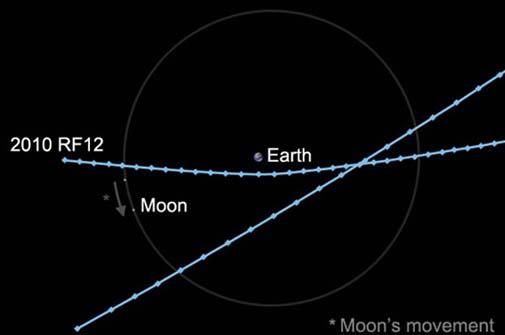Duck!
Today, two asteroids pass the Earth at a fairly snug distance. One, 2010 RX30, went by just before 6:00 a.m. EDT about 154,000 miles above the northern Pacific Ocean. That’s equivalent to three-fifths the distance to the moon. The other one, 2010 RF12, goes by just after 5:00 p.m. EDT, above Antarc…
Today, two asteroids pass the Earth at a fairly snug distance. One, 2010 RX30, went by just before 6:00 a.m. EDT about 154,000 miles above the northern Pacific Ocean. That's equivalent to three-fifths the distance to the moon. The other one, 2010 RF12, goes by just after 5:00 p.m. EDT, above Antarctica, and offers a slightly closer shave: 49,000 miles, a bit bit more than twice the altitude of a geostationary communications satellite.

The first rock was a maximum of 65 feet in diameter, and the second a max of 46 feet. So even if they made a direct hit on the home planet—even though they'd each unleash the force of multiple Hiroshima-size atomic bombs—they'd do so tens of thousands of feet up in the atmosphere. If it happened over land, which covers thirty percent of the planet, it probably wouldn't come close to the destructive power of the Tunguska Event of 1908. That object might have been a stony asteroid a couple hundred feet in diameter, or a more loosely packed comet a few thousand feet in diameter. Either way, not even that object made it near the ground, and probably exploded three-to-six miles high. Still, Tunguska unleashed a few thousand times the force of a Hiroshima explosion, and flattened 830 square miles of Siberian forest.

Astronomers guess that asteroids up to 35 feet in diameter shoot by within the Earth-moon distance of 240,000 miles about once a day, and enter the planet's atmosphere perhaps once every ten years. Asteroids ten times that size arrive on average every 10,000 years. Both of today's asteroids are close enough to be visible through amateur telescopes.
Seeing as how this subject has a direct bearing on human survival, it's a topic we're interested in at Air & Space. Read our article about meteors.

The first rock was a maximum of 65 feet in diameter, and the second a max of 46 feet. So even if they made a direct hit on the home planet—even though they'd each unleash the force of multiple Hiroshima-size atomic bombs—they'd do so tens of thousands of feet up in the atmosphere. If it happened over land, which covers thirty percent of the planet, it probably wouldn't come close to the destructive power of the Tunguska Event of 1908. That object might have been a stony asteroid a couple hundred feet in diameter, or a more loosely packed comet a few thousand feet in diameter. Either way, not even that object made it near the ground, and probably exploded three-to-six miles high. Still, Tunguska unleashed a few thousand times the force of a Hiroshima explosion, and flattened 830 square miles of Siberian forest.

Astronomers guess that asteroids up to 35 feet in diameter shoot by within the Earth-moon distance of 240,000 miles about once a day, and enter the planet's atmosphere perhaps once every ten years. Asteroids ten times that size arrive on average every 10,000 years. Both of today's asteroids are close enough to be visible through amateur telescopes.
Seeing as how this subject has a direct bearing on human survival, it's a topic we're interested in at Air & Space. Read our article about meteors.